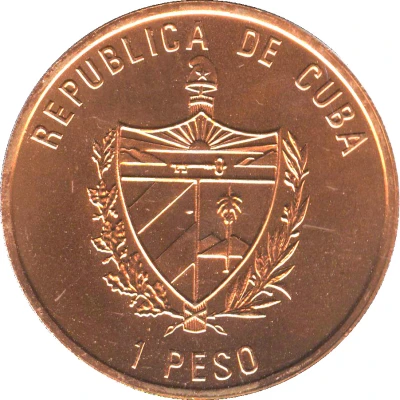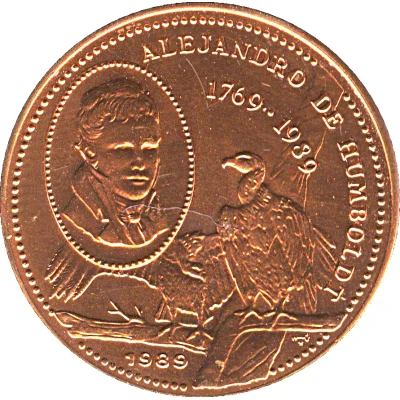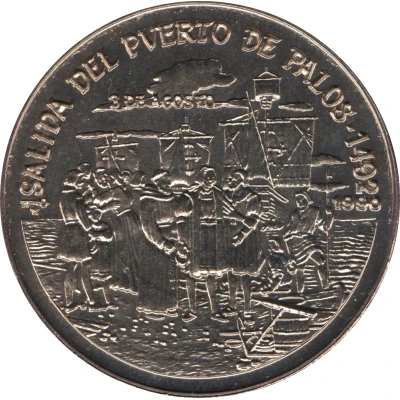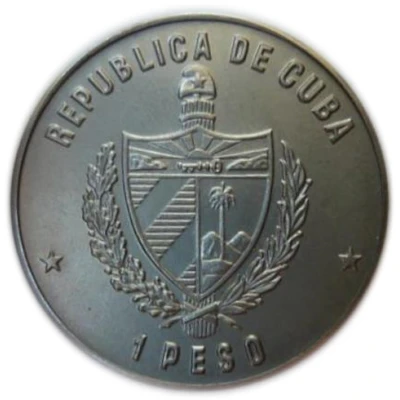
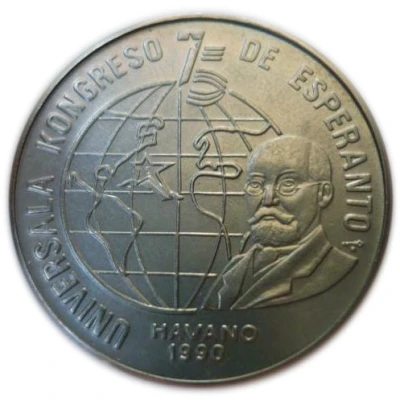

© Emiliano Micalizzi
1 Peso Esperanto Congress
1990 year| Copper-nickel | 11.3 g | 29.9 mm |
| Issuer | Cuba |
|---|---|
| Period | Second Republic (1959-date) |
| Type | Non-circulating coin |
| Year | 1990 |
| Value | 1 Peso (1 CUP) |
| Currency | Cuban Peso (moneda nacional, 1914-date) |
| Composition | Copper-nickel |
| Weight | 11.3 g |
| Diameter | 29.9 mm |
| Shape | Round |
| Technique | Milled |
| Orientation | Coin alignment ↑↓ |
| Demonetized | 1990 |
| Updated | 2024-10-04 |
| Numista | N#14174 |
|---|---|
| Rarity index | 52% |
Reverse
Dr. Luis Lázaro Zamenhof at right, stylized world globe behind, enhanced Cuba shape with a 5-pointed star on it, letter "E" within; stylized numbers "75" on top, event name as curved legend, in Esperanto language, from bottom to left, top and right. Mintmark on right, place and year on bottom.
Script: Latin
Lettering:
UNIVERSALA KONGRESO 75 DE ESPERANTO
HAVANO
1990
Translation:
(Legends written in Esperanto language)
Universal 75 Esperanto Congress
Havana
1990
Edge
Plain
Comment
Esperanto is the most known artificial language, that was created by Dr. Luis Lázaro Zamenhof, Polish ophthalmologist, from end of 1870 decade, till middle 1880's. First grammatical rules (only 16 rules) were published on 1887 at Warshaw.First Esperanto Congress was held at Boulogne-sur-Mer, France, in 1905, and is celebrated every year (except on gaps owing to WorldsWars), in different cities of the world. 2020 and 2021 versions were virtual, on Internet, owing to sanitary world situation.
1990 Congress was organized at Havana, as 75th. edition.
Esperanto language is based on several modern languages, has no irregular rules, and it structure allows words be constructed using segments to create new words, that can be understood by knowing the structure. Adjectives, sustantives, are created by certain endings to root word, and has no regional variations as common on natural languages. Owing to its simple structure, small amount of root words, and gramatical rules is easy to learn and understand. Same happens on writing, cause alphabet (28 letters) is totally phonetic, does not use similar letters (q, w, x, y, except for foreign names not converted) and adds 6 accented letters for some needed sounds
Some micro nations already have adopted Esperanto as official language (always with the original one), and some cities and regions use it as a second language; i.e. in road signs.
Interesting fact
The 1990 Cuban Esperanto Congress coin is unique in that it features the Esperanto language on its obverse side, which is not commonly seen on coins. Esperanto is a constructed language that was created in the late 19th century with the goal of creating a language that would be easy to learn and could be used as a neutral, second language for people from different countries. The use of Esperanto on this coin reflects Cuba's interest in promoting international understanding and communication.
Price
| Date | Mintage | VG | F | VF | XF | AU | UNC |
|---|---|---|---|---|---|---|---|
| 1990 | 6000 | - | - | - | - | - | - |
Values in the table are based on evaluations by sales realized on Internet platforms. They serve as an indication only for 1 Peso (Esperanto Congress) 1990 coin.
